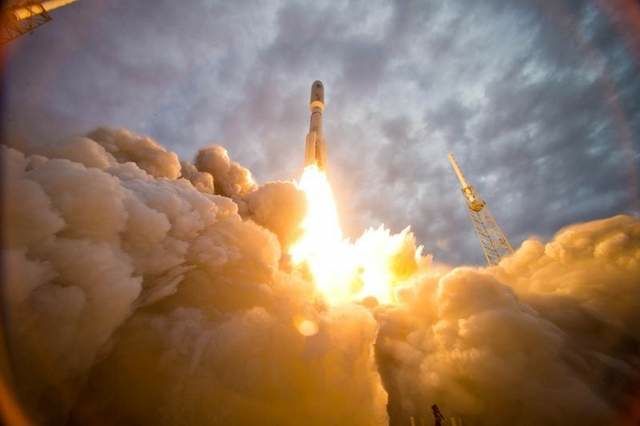
CORRECTED: Raytheon Builds VIIRS
WASHINGTON: The Trump Administration’s new Space Council should tackle the thorny interagency problem of how much the Air Force will do to provide weather data to the US government, says the chairman of the House subcommittee that deals with space policy.
More than a decade has passed since difficult technical problems caused prolonged delays to the launch of a critical weather sensor known as VIIRS. A key part of what was to be the NPOESS super weather satellite, VIIRS (pronounced “Veers”) stands for Visible Infrared Imaging Radiometer Suite,
The key function for Raytheon’s VIIRS (ed note: I had Northrop, based on fact they were NPOESS prime) is its ability to monitor ocean color, which indicates the health of two-thirds of our planet’s surface. It also gathers visible and infrared imagery, radiometric data on the atmosphere and sea surface temperature, among other things.
Rep. Brian Babin, chairman of the House Space subcommittee, summed up the VIIRS situation nicely in a talk this morning organized by the Aerospace Corp. and George Washington University’s Space Policy Institute:
“After the cancellation of the National Polar-Orbiting Environmental Satellite System (NPOESS) because of bureaucratic failures, the National Oceanic and Atmospheric Administration took on the responsibility of providing weather data in the afternoon orbit, European partners were to provide data in the mid-morning orbit, and the Department of Defense was to provide weather data from the early morning orbit.
“While NOAA has held up its end of the deal and is poised to launch the first Joint Polar Satellite System mission this fall, the DoD still has not decided how it will satisfy its obligation,” he told the invitation-only crowd. “There is no guarantee that the DoD will include the Visible Infrared Imaging Radiometer Suite which was more of a DoD priority than a NOAA priority before the breakup of the original program. Given the significant investment in developing VIIRS, it would be a shame if DoD did not live up to its end of the bargain and fly VIIRS. As it stands, the civil space sector is essentially subsidizing national security space but not receiving reciprocal support.”
Intriguingly, Babin was speaking directly to Scott Pace, nominated this week to become the Trump Administration’s Space Council’s executive director, who was in the audience. So Pace knows what this influential space lawmaker thinks he should be working on. As Babin noted, he has twice flown with Vice President Mike Pence, who leads the Space Council, to space events in the last few weeks so he appears to have some political reach in the White House.
VIIRS was not the only issue Babin thought could use Space Council focus. He called for an “holistic assessment” of the nation’s launch capabilities, including the Evolved Expendable Launch Vehicle (EELV), NASA’s Commercial Cargo program and the development of the commercial crew program and the Space Launch System. “DoD,” he said, “and NASA have different requirements so it is logical that they would have different vehicles, but there are opportunities to better align the two agencies activities. For instance, the Space Launch System provides a wide fairing capable to launching larger optics and arrays. Similarly, efforts at both DoD and NASA on small class launch vehicles could benefit from better coordination.”

Russian-made RD-180 engines propel an Atlas V rocket heavenward.
Satellite servicing is another area that could benefit from the council’s collective wisdom. “NASA’s Restore-L program and DARPA’s Robotic Surviving of Geosynchronous Satellites (RSGS) program are focused on very similar goals. Coordinating and deconflicting those activities seems like a logical role for the Council,” Babin said.
Finally, he also said space weather and Space Situational Awareness (SSA) should get some Pace’s attention. “Just like traditional weather, space weather observations involve many agencies. NASA conducts heliophysics research with in-space observations. The National Science foundation conducts ground based observations and supports basic research. The DoD and NOAA conduct space weather observations and forecasts to protect U.S. government assets. The Department of Energy, the Department of Transportation, and the Department of Homeland Security are also interested in understanding the state of space weather because of its risk to the power grid, aviation, and homeland security,” Babin noted
On SSA, he correctly pointed out that there is “no consensus on what, if anything, the federal government should do about SSA going forward, but there are many different ideas being discussed.”
How much should the government dedicate to a commercial “storefront”? Would, the chairman wondered, transferring authority to a civilian agency “actually save money? How would this impact international cooperation and space operations security?”
He said the government should explore more options than the Obama administration’s idea of having the Transportation Department take over DoD’s responsibilities. “If Congress decides a civil agency should have a role, should NASA or the Department of Commerce be responsible instead of the FAA?”
He pointed to the array of companies, such as AGI, that provide SSA and questioned the ability of the FAA, which has never dealt with space issues, to take them on straight away.
“We should,” he said, “stoke the embers of private sector creativity, not smother them with a bureaucratic blanket.” Truly, the words of a staunch conservative Republican. We’re betting that Pace was listening closely.
Major trends and takeaways from the Defense Department’s Unfunded Priority Lists
Mark Cancian and Chris Park of CSIS break down what is in this year’s unfunded priority lists and what they say about the state of the US military.


























